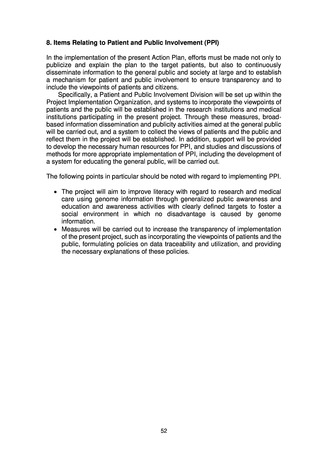よむ、つかう、まなぶ。
参考資料4_Action plan for whole genome analysis 2022 (42 ページ)
出典
| 公開元URL | https://www.mhlw.go.jp/stf/newpage_34345.html |
| 出典情報 | 厚生科学審議会 科学技術部会 全ゲノム解析等の推進に関する専門委員会(第16回 7/226)《厚生労働省》 |
ページ画像
ダウンロードした画像を利用する際は「出典情報」を明記してください。
低解像度画像をダウンロード
プレーンテキスト
資料テキストはコンピュータによる自動処理で生成されており、完全に資料と一致しない場合があります。
テキストをコピーしてご利用いただく際は資料と付け合わせてご確認ください。
Use of cloud computing (external storage, external access) is to be
considered in areas that handle workflows directly related to clinical
practice. In addition, the requirements of the guidelines for safety
management of medical information systems (security design for web
applications such as multi-factor authentication for data access, virtual
private network [VPN], and cookie acquisition, correction of
vulnerabilities, sanitization, etc.) will be met to ensure thorough project
security and data quality.
o Clinical genome analysis and advanced cross-sectional analysis
The Analysis and Data Center will collect sequencing data, etc. from
sequencing companies to build a genome database and will also
automatically collect clinical information from medical institutions using
an API to build a clinical information database. In addition, as well as
analyzing sequencing data by means of a unified pipeline, the Analysis
and Data Center will collaborate with industry and academe to conduct
advanced cross-sectional analyses to clarify the medical significance of
new mutations.
Construction of the genome database
The sequencing data collected from sequencing companies (FASTQ
data), the bam (or cram) files generated from the unified pipeline, and
the mutation information (VCF files) will be compiled into a database at
the Analysis and Data Center.
Systems and infrastructure will be created that are capable of storing
the results of primary analysis (mapping, variant calls) and quality checks
of whole genome sequencing data (tumor 120, normal 30) from
around 10,000 cases per year.
Collection of clinical information
Information relating to outcomes such as prognosis or mortality and
information on drugs or therapeutic methods that correspond to
mutations will be important clinical information for collection. In FY2022,
the data format of clinical information will be standardized as much as
possible at the various medical institutions, and the input format
(template) will be standardized. At the same time, there will be
development aimed at the future implementation of an automatic clinical
information collection method using APIs. A cloud computing system will
also be constructed to create a database of the clinical information that
is collected.
• API automatic collection method
Clinical information will be automatically collected using APIs. The aim
is ultimately to lessen the burden on physicians of clinical data collection
by using AI for natural language processing of the free-written content in
templates and medical records. An open data source API for transferring
clinical information from electronic medical records and an API for data
access will be developed in FY2022. In this regard, the following points
should be noted.
41
considered in areas that handle workflows directly related to clinical
practice. In addition, the requirements of the guidelines for safety
management of medical information systems (security design for web
applications such as multi-factor authentication for data access, virtual
private network [VPN], and cookie acquisition, correction of
vulnerabilities, sanitization, etc.) will be met to ensure thorough project
security and data quality.
o Clinical genome analysis and advanced cross-sectional analysis
The Analysis and Data Center will collect sequencing data, etc. from
sequencing companies to build a genome database and will also
automatically collect clinical information from medical institutions using
an API to build a clinical information database. In addition, as well as
analyzing sequencing data by means of a unified pipeline, the Analysis
and Data Center will collaborate with industry and academe to conduct
advanced cross-sectional analyses to clarify the medical significance of
new mutations.
Construction of the genome database
The sequencing data collected from sequencing companies (FASTQ
data), the bam (or cram) files generated from the unified pipeline, and
the mutation information (VCF files) will be compiled into a database at
the Analysis and Data Center.
Systems and infrastructure will be created that are capable of storing
the results of primary analysis (mapping, variant calls) and quality checks
of whole genome sequencing data (tumor 120, normal 30) from
around 10,000 cases per year.
Collection of clinical information
Information relating to outcomes such as prognosis or mortality and
information on drugs or therapeutic methods that correspond to
mutations will be important clinical information for collection. In FY2022,
the data format of clinical information will be standardized as much as
possible at the various medical institutions, and the input format
(template) will be standardized. At the same time, there will be
development aimed at the future implementation of an automatic clinical
information collection method using APIs. A cloud computing system will
also be constructed to create a database of the clinical information that
is collected.
• API automatic collection method
Clinical information will be automatically collected using APIs. The aim
is ultimately to lessen the burden on physicians of clinical data collection
by using AI for natural language processing of the free-written content in
templates and medical records. An open data source API for transferring
clinical information from electronic medical records and an API for data
access will be developed in FY2022. In this regard, the following points
should be noted.
41

























































